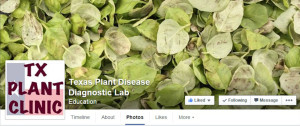By Kathleen Phillips
If you “like” the Texas Plant Diagnostic Lab on Facebook, it’s probably because there is something happening to your plants that you definitely do not like.
Seeing yellow leaves on basil or black spots on Indian hawthornleaves, for example, is much the same for a plant as coughing or having a rash is for humans. They mean a sickness is present, and there may be ways to treat it before it worsens, according to Dr. Kevin Ong, director of Texas A&M AgriLife Extension Service’s Texas Plant Disease Diagnostic Lab in College Station.
“Facebook is a tool that lets us provide information with many people who might be interested in what we have to share,” said Ong, who started the lab’s Facebook page, https://www.facebook.com/TXPlantClinic, in 2009.

The Texas Plant Disease Diagnostic Lab Facebook presence is an outlet to educate and help folks to know what kinds/types of samples to send for a quality diagnosis. It is also a way to increase awareness of our fans to newly emerging, common or seasonal issues – some of which can be taken care of easily. (Photo courtesy of Texas A&M AgriLife Extension Service).
The plant disease diagnostic lab, often simply called the Plant Clinic, provides diagnostic and education support about plants for the people of Texas, Ong said. Home gardeners and commercial growers are welcome to provide samples to the clinic for a low-cost diagnosis and information about diseases, prevention and treatment.
“Physical sample submission to the lab is still the best approach to get an accurate diagnosis to your plant problems,” Ong said. “And social media is an excellent outlet to educate and help folks to know what kinds/types of samples to send for a quality diagnosis. It is also a great way to increase awareness of our fans to newly emerging, common or seasonal issues – some of which can be taken care of easily.”
The clinic’s staff posts pictures of the “sample of the week” from specimens received at the lab. These postsusually address common plant issues that may be indicative of problems others may be experiencing on their plants at the time. They also post links to publications that describe common problems such as basil downy mildew or leaf spot on live oaks.
Ong keeps watch on situations developing outside of Texas as well, and posts to the site so that others can be on the lookout. He recently posted about a new U.S. pest, the spotted lanternfly found in Pennsylvania earlier this month, and gave advice on what to do if the insect is spotted in Texas.
“This one is not too friendly on fruits — grapes, stone fruit and a bunch of others,” he posted. “Hope that it will not get to Texas. So Texas peeps – if you see something like this, call your Extension county office or us at the TX Plant Clinic.”
Ong welcomes posts and photos to the page from people seeking information about what’s ailing their plants. He provides information through comments on those posts.
Source:"agrilife.org"